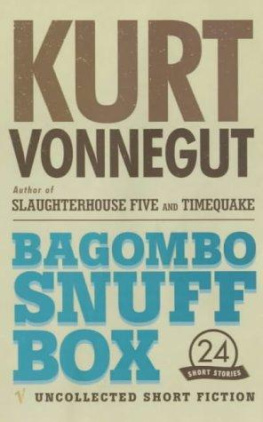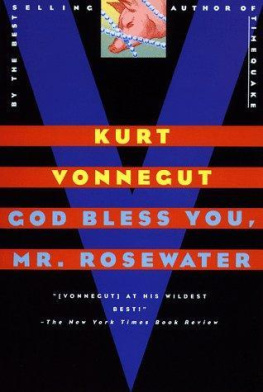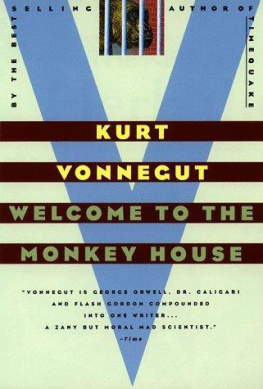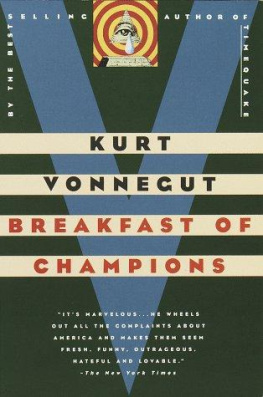Copyright 2012 by The Kurt Vonnegut, Jr. Trust
Illustrations Kurt Vonnegut and the Origami Express
All rights reserved.
Published in the United States by Delacorte Press, an imprint of The Random House Publishing Group, a division of Random House, Inc., New York.
D ELACORTE P RESS is a registered trademark of Random House, Inc., and the colophon is a trademark of Random House, Inc.
Grateful acknowledgment is made to the following for permission to reprint previously published material:
D ELL B OOKS, A D IVISION OF R ANDOM H OUSE , I NC.: Letter from Kurt Vonnegut, Jr., to Charles Drake dated November 16, 1973, from Palm Sunday by Kurt Vonnegut, copyright 1981 by Kurt Vonnegut. Reprinted by permission of Dell Books, a division of Random House, Inc.; A LFRED A. K NOPF, A D IVISION OF R ANDOM H OUSE , I NC ., F ABER & F ABER L IMITED, AND C URTIS B ROWN , L TD.: Excerpt from Markings by Dag Hammarskjold, translated by W. H. Auden and Leif Sjberg, translation copyright 1964 and copyright renewed 1992 by Alfred A. Knopf, a division of Random House, Inc., and Faber & Faber Ltd. Foreword copyright 1964 by W. H. Auden and copyright renewed 1992 by Edward Mendelson. Rights throughout Canada and the United Kingdom are controlled by Faber & Faber Limited. Electronic book rights are controlled by Curtis Brown, Ltd. Reprinted by permission of Alfred A. Knopf, a division of Random House, Inc., Faber & Faber Limited, and Curtis Brown, Ltd.; G. P. P UTNAM S S ONS, A D IVISION OF P ENGUIN G ROUP (USA) I NC. AND J ONATHAN C APE, A M EMBER OF THE R ANDOM H OUSE G ROUP L IMITED: Letter from PFC Kurt Vonnegut, Jr., to his family dated May 29, 1945, from Armageddon in Retrospect by Kurt Vonnegut, Jr., copyright 2008 by the Kurt Vonnegut, Jr. Trust. Used by permission of G. P. Putnams Sons, a division of Penguin Group (USA) Inc. and Jonathan Cape, a member of the Random House Group Limited.
Photo credits for insert on .
Library of Congress Cataloging-in-Publication Data
Vonnegut, Kurt.
Kurt Vonnegut: letters/edited by Dan Wakefield.
p. cm.
eISBN: 978-0-345-53539-9
1. Vonnegut, KurtCorrespondence. I. Wakefield, Dan. II. Title.
PS3572.O5Z48 2012
813.54dc23 2012001544
www.bantamdell.com
All drawings courtesy of The Kurt Vonnegut Trust, Donald C. Farber, Trustee.
Postcard on courtesy of Asa Pieratt.
Jacket design: Lynn Buckley
Jacket photograph: Dmitri Kasterine
v3.1
CONTENTS
INTRODUCTION
The letters by Kurt Vonnegut collected in this book tell the story of a writers lifea writer whose influence is still widely felt throughout the world and, by every indication, will continue to be felt for a long time to come. They are as personal, as witty, as entertaining, and as disarmingly profound as the work he published in novels, stories, articles, and essays. No outside interpreter will ever be able to express this life as truly and as deeply as these letters he wrote to his children, his friends, his publishers, his academic advocates, his critics, and those who sought to ban his work.
Reading these letters has allowed me to know my friend Kurt Vonnegut better and to appreciate him even more. Nothing came easy for him. Nothing deterred himnot the many editors and publishers who rejected his books and stories; not the anthropology department of the University of Chicago, which rejected not one but two of the theses he wrote for his M.A. degree (awarding it to him only after he was famous); not the Guggenheim Foundation, which rejected his first application for a fellowship; not the doubting relatives and friends from home like his uncle Alex, who said he couldnt read The Sirens of Titan, after Kurt had dedicated the book to him, or his aunt Ella Stewart, who would not stock his books in the bookstore she owned in Louisville, Kentucky, because she found them degenerate; not his Cape Cod neighbors who didnt read his books and expressed no interest in what he did for a living; not the school boards that banned his books (and in one case burned them in a furnace) without ever reading them; not the academic critics who spurned and dismissed him; not the backbiting reviewers who tried to drag him down after he became famous; not the bureaucrats he battled for the rights of writers throughout the world; not the right-wing Christian religious groups that condemned this man who described Jesus Christ as the greatest and most humane of human beings. Anyone who imagines a writers life has ever been easyeven one who eventually achieves fame and fortunewill be disabused of that fantasy after reading these letters. And they will be inspired.

I first heard the name Kurt Vonnegut in the spring of 1950, my senior year at Shortridge High School in Indianapolis, when I admitted to a teacher that I wanted to be a writer. His brows furrowed in concern, he rubbed his chin for a moment, nodded, and said, Well, theres one boy did thatboy named Vonnegut. I learned that the Vonnegut boy, who got his start writing for the Shortridge Daily Echo, had published his first short story in Colliers magazine earlier that year. To me, that meant he had reached Mount Olympus.
Neither that high school teacher nor anyone else in the worldwith the exception of his childhood sweetheart and high school classmate, Jane Marie Cox, who became his first wife and the mother of his first three childrenbelieved that Vonnegut would become a world-famous writer whose work would be translated into all the major languages of the world. His oldest son, Mark, wrote in his memoir, Just Like Someone Without Mental Illness Only More So, that during the years of Kurts struggles, My mother knew my father was going to be famous and it was all going to be worth it. She believed more than he did that he would someday be a famous writer.
Growing up in Indianapolis in the 1930s and 40s, my friends and I and our families all knew the name Vonnegutthe Vonnegut Hardware Company had its headquarters downtown, and there were branches throughout the city. In summers during high school, Kurt worked at the main store for his great-uncle Franklin Vonnegut, making up packages in the shipping room and for a while running a freight elevator. He later wrote to a fan in Indianapolis who had also worked in that store: My idea of hell was shaped by that experience. Hell is running an elevator throughout eternity in a building with only six floors. But he respected the company begun by his ancestors, commenting in Palm Sunday: I liked what we sold. It was honest and practical.
I knew as a kid what the Vonneguts had contributed to the city in terms of business, but I was ignorant until much later of the familys immense cultural contributions. Kurts great-grandfather, Clemens Vonnegut, emigrated from Germany in 1848 and settled in Indianapolis in 1850 and not only established the Vonnegut Hardware Company but also became a major influence in the citys cultural affairs. He founded the Freethinkers Society of Indianapolis and the Indianapolis Turngemeinde, the center for German culture and gymnastics in Indianapolis. It later became known as the Athenaeum Turners, serving the whole community and offering theater, lectures, and music as well as gymnastics. The building that houses it today is called the Athenaeum.



















